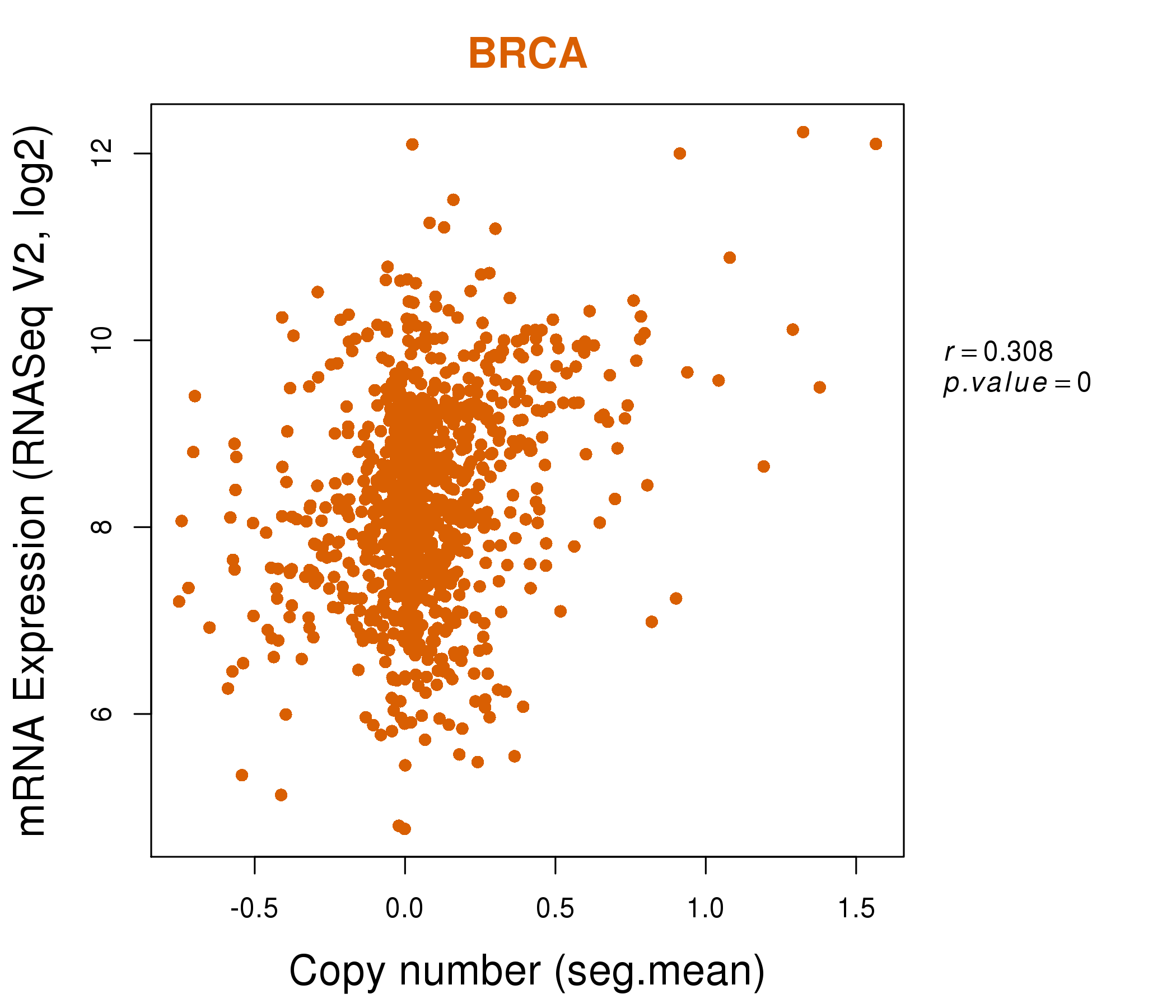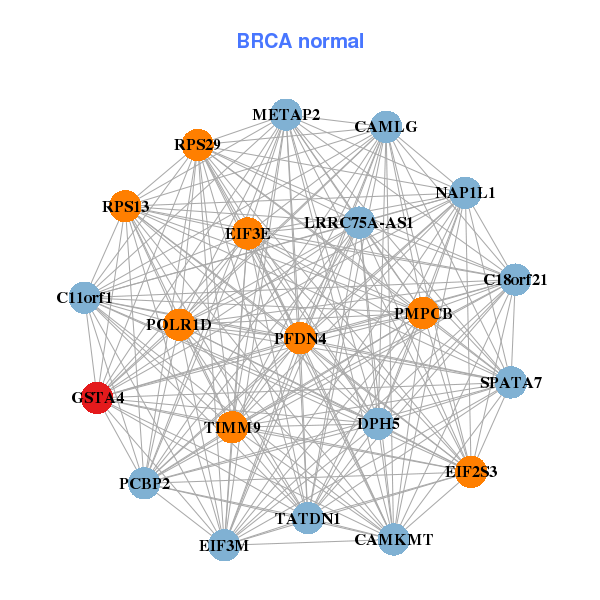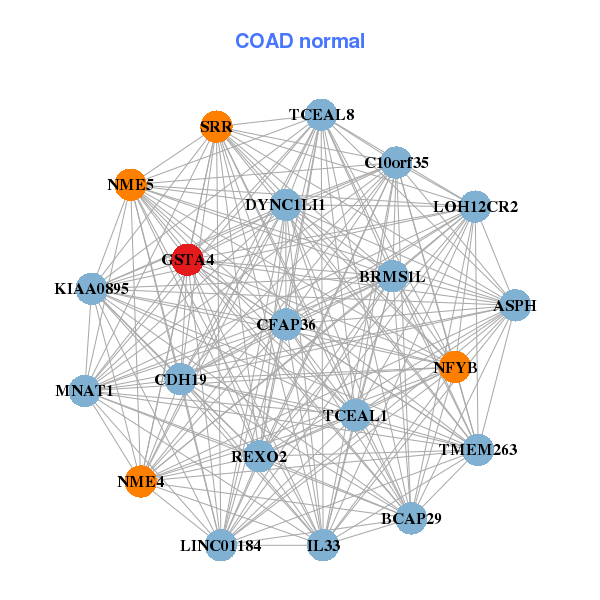|
||||||||||||||||||||
| |
| Phenotypic Information (metabolism pathway, cancer, disease, phenome) |
| |
| |
| Gene-Gene Network Information: Co-Expression Network, Interacting Genes & KEGG |
| |
|
| Gene Summary for GSTA4 |
| Basic gene info. | Gene symbol | GSTA4 |
| Gene name | glutathione S-transferase alpha 4 | |
| Synonyms | GSTA4-4|GTA4 | |
| Cytomap | UCSC genome browser: 6p12.1 | |
| Genomic location | chr6 :52842745-52860178 | |
| Type of gene | protein-coding | |
| RefGenes | NM_001512.3, | |
| Ensembl id | ENSG00000170899 | |
| Description | GST class-alpha member 4S-(hydroxyalkyl)glutathione lyase A4glutathione S-alkyltransferase A4glutathione S-aralkyltransferase A4glutathione S-aryltransferase A4glutathione S-transferase A4glutathione S-transferase A4-4glutathione transferase A4-4 | |
| Modification date | 20141207 | |
| dbXrefs | MIM : 605450 | |
| HGNC : HGNC | ||
| Ensembl : ENSG00000170899 | ||
| HPRD : 06899 | ||
| Vega : OTTHUMG00000014868 | ||
| Protein | UniProt: go to UniProt's Cross Reference DB Table | |
| Expression | CleanEX: HS_GSTA4 | |
| BioGPS: 2941 | ||
| Gene Expression Atlas: ENSG00000170899 | ||
| The Human Protein Atlas: ENSG00000170899 | ||
| Pathway | NCI Pathway Interaction Database: GSTA4 | |
| KEGG: GSTA4 | ||
| REACTOME: GSTA4 | ||
| ConsensusPathDB | ||
| Pathway Commons: GSTA4 | ||
| Metabolism | MetaCyc: GSTA4 | |
| HUMANCyc: GSTA4 | ||
| Regulation | Ensembl's Regulation: ENSG00000170899 | |
| miRBase: chr6 :52,842,745-52,860,178 | ||
| TargetScan: NM_001512 | ||
| cisRED: ENSG00000170899 | ||
| Context | iHOP: GSTA4 | |
| cancer metabolism search in PubMed: GSTA4 | ||
| UCL Cancer Institute: GSTA4 | ||
| Assigned class in ccmGDB | C | |
| Top |
| Phenotypic Information for GSTA4(metabolism pathway, cancer, disease, phenome) |
| Cancer | CGAP: GSTA4 |
| Familial Cancer Database: GSTA4 | |
| * This gene is included in those cancer gene databases. |
|
|
|
|
|
| . | ||||||||||||||
Oncogene 1 | Significant driver gene in | |||||||||||||||||||
| cf) number; DB name 1 Oncogene; http://nar.oxfordjournals.org/content/35/suppl_1/D721.long, 2 Tumor Suppressor gene; https://bioinfo.uth.edu/TSGene/, 3 Cancer Gene Census; http://www.nature.com/nrc/journal/v4/n3/abs/nrc1299.html, 4 CancerGenes; http://nar.oxfordjournals.org/content/35/suppl_1/D721.long, 5 Network of Cancer Gene; http://ncg.kcl.ac.uk/index.php, 1Therapeutic Vulnerabilities in Cancer; http://cbio.mskcc.org/cancergenomics/statius/ |
| KEGG_GLUTATHIONE_METABOLISM KEGG_METABOLISM_OF_XENOBIOTICS_BY_CYTOCHROME_P450 KEGG_DRUG_METABOLISM_CYTOCHROME_P450 | |
| OMIM | |
| Orphanet | |
| Disease | KEGG Disease: GSTA4 |
| MedGen: GSTA4 (Human Medical Genetics with Condition) | |
| ClinVar: GSTA4 | |
| Phenotype | MGI: GSTA4 (International Mouse Phenotyping Consortium) |
| PhenomicDB: GSTA4 | |
| Mutations for GSTA4 |
| * Under tables are showing count per each tissue to give us broad intuition about tissue specific mutation patterns.You can go to the detailed page for each mutation database's web site. |
| - Statistics for Tissue and Mutation type | Top |
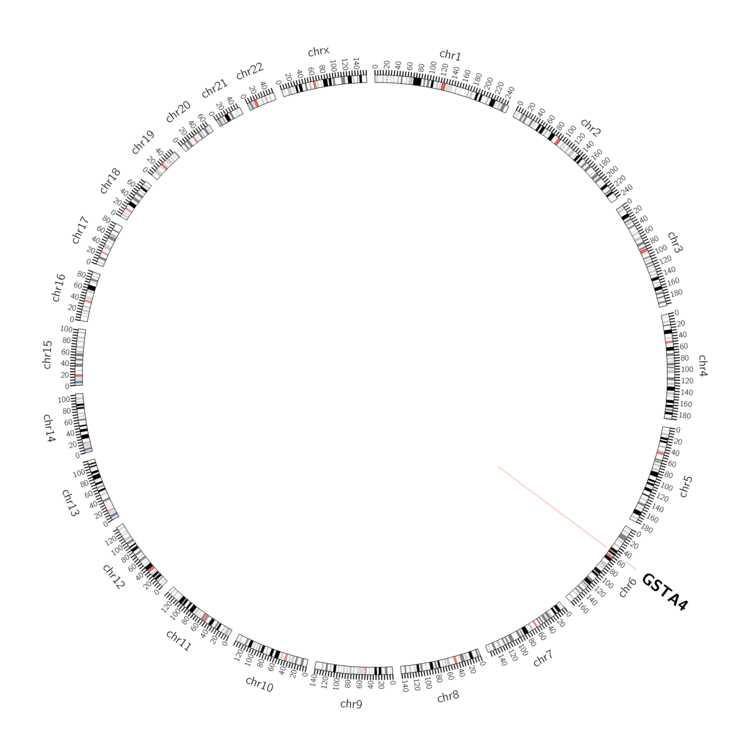 |
| - For Inter-chromosomal Variations |
| There's no inter-chromosomal structural variation. |
| - For Intra-chromosomal Variations |
| * Intra-chromosomal variantions includes 'intrachromosomal amplicon to amplicon', 'intrachromosomal amplicon to non-amplified dna', 'intrachromosomal deletion', 'intrachromosomal fold-back inversion', 'intrachromosomal inversion', 'intrachromosomal tandem duplication', 'Intrachromosomal unknown type', 'intrachromosomal with inverted orientation', 'intrachromosomal with non-inverted orientation'. |
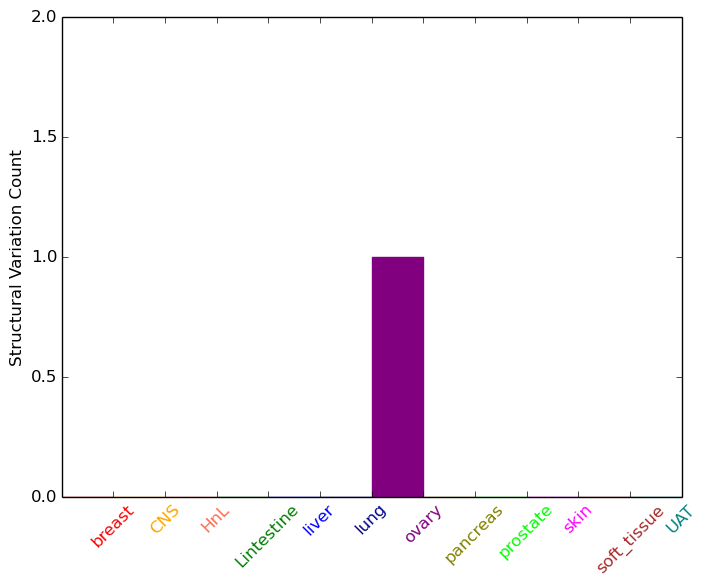 |
| Sample | Symbol_a | Chr_a | Start_a | End_a | Symbol_b | Chr_b | Start_b | End_b |
| ovary | GSTA4 | chr6 | 52857321 | 52857341 | chr6 | 52861688 | 52861708 |
| cf) Tissue number; Tissue name (1;Breast, 2;Central_nervous_system, 3;Haematopoietic_and_lymphoid_tissue, 4;Large_intestine, 5;Liver, 6;Lung, 7;Ovary, 8;Pancreas, 9;Prostate, 10;Skin, 11;Soft_tissue, 12;Upper_aerodigestive_tract) |
| * From mRNA Sanger sequences, Chitars2.0 arranged chimeric transcripts. This table shows GSTA4 related fusion information. |
| ID | Head Gene | Tail Gene | Accession | Gene_a | qStart_a | qEnd_a | Chromosome_a | tStart_a | tEnd_a | Gene_a | qStart_a | qEnd_a | Chromosome_a | tStart_a | tEnd_a |
| BX477527 | LRRK1 | 1 | 72 | 15 | 101555467 | 101555538 | GSTA4 | 67 | 570 | 6 | 52849831 | 52850334 | |
| Top |
| There's no copy number variation information in COSMIC data for this gene. |
| Top |
|
 |
| Top |
| Stat. for Non-Synonymous SNVs (# total SNVs=22) | (# total SNVs=0) |
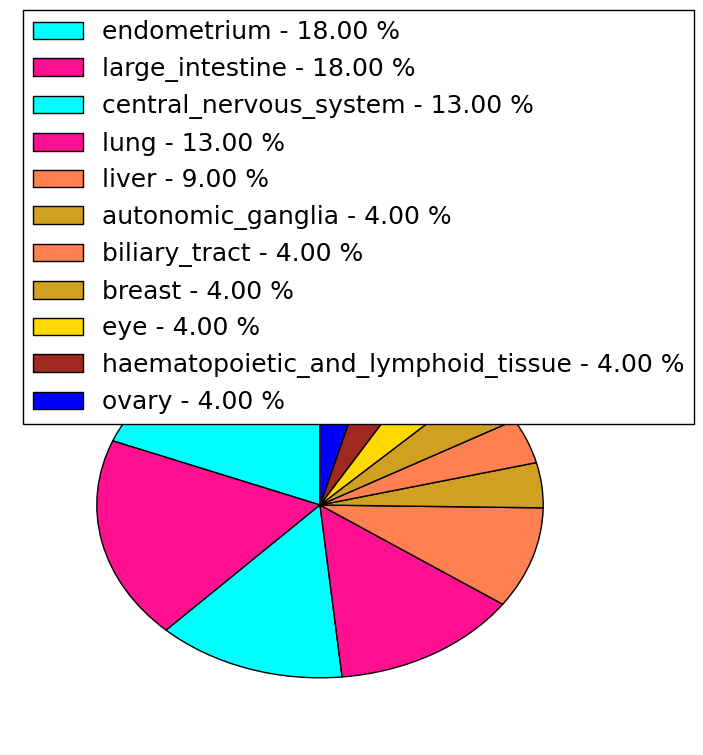 | |
(# total SNVs=1) | (# total SNVs=0) |
 |
| Top |
| * When you move the cursor on each content, you can see more deailed mutation information on the Tooltip. Those are primary_site,primary_histology,mutation(aa),pubmedID. |
| GRCh37 position | Mutation(aa) | Unique sampleID count |
| chr6:52849366-52849366 | p.E104K | 2 |
| chr6:52852158-52852158 | p.D46Y | 2 |
| chr6:52847488-52847488 | p.G144R | 2 |
| chr6:52850344-52850344 | p.E59D | 2 |
| chr6:52843291-52843291 | p.V216I | 2 |
| chr6:52849353-52849353 | p.M108K | 1 |
| chr6:52850376-52850376 | p.H49Y | 1 |
| chr6:52843335-52843335 | p.G201V | 1 |
| chr6:52843336-52843336 | p.G201C | 1 |
| chr6:52849383-52849383 | p.G98E | 1 |
| Top |
|
 |
| Point Mutation/ Tissue ID | 1 | 2 | 3 | 4 | 5 | 6 | 7 | 8 | 9 | 10 | 11 | 12 | 13 | 14 | 15 | 16 | 17 | 18 | 19 | 20 |
| # sample | 1 | 2 | 1 | 2 | 2 | 1 | 2 | 4 | ||||||||||||
| # mutation | 1 | 2 | 1 | 2 | 2 | 1 | 2 | 4 | ||||||||||||
| nonsynonymous SNV | 1 | 2 | 2 | 2 | 1 | 1 | 4 | |||||||||||||
| synonymous SNV | 1 | 1 |
| cf) Tissue ID; Tissue type (1; BLCA[Bladder Urothelial Carcinoma], 2; BRCA[Breast invasive carcinoma], 3; CESC[Cervical squamous cell carcinoma and endocervical adenocarcinoma], 4; COAD[Colon adenocarcinoma], 5; GBM[Glioblastoma multiforme], 6; Glioma Low Grade, 7; HNSC[Head and Neck squamous cell carcinoma], 8; KICH[Kidney Chromophobe], 9; KIRC[Kidney renal clear cell carcinoma], 10; KIRP[Kidney renal papillary cell carcinoma], 11; LAML[Acute Myeloid Leukemia], 12; LUAD[Lung adenocarcinoma], 13; LUSC[Lung squamous cell carcinoma], 14; OV[Ovarian serous cystadenocarcinoma ], 15; PAAD[Pancreatic adenocarcinoma], 16; PRAD[Prostate adenocarcinoma], 17; SKCM[Skin Cutaneous Melanoma], 18:STAD[Stomach adenocarcinoma], 19:THCA[Thyroid carcinoma], 20:UCEC[Uterine Corpus Endometrial Carcinoma]) |
| Top |
| * We represented just top 10 SNVs. When you move the cursor on each content, you can see more deailed mutation information on the Tooltip. Those are primary_site, primary_histology, mutation(aa), pubmedID. |
| Genomic Position | Mutation(aa) | Unique sampleID count |
| chr6:52850344 | p.P208T | 1 |
| chr6:52843335 | p.G201V | 1 |
| chr6:52850346 | p.I174I | 1 |
| chr6:52847396 | p.E169D | 1 |
| chr6:52850376 | p.P134L | 1 |
| chr6:52847411 | p.K119N | 1 |
| chr6:52852158 | p.G98G | 1 |
| chr6:52849275 | p.E97D | 1 |
| chr6:52849319 | p.Y95H | 1 |
| chr6:52849382 | p.K84N | 1 |
| * Copy number data were extracted from TCGA using R package TCGA-Assembler. The URLs of all public data files on TCGA DCC data server were gathered on Jan-05-2015. Function ProcessCNAData in TCGA-Assembler package was used to obtain gene-level copy number value which is calculated as the average copy number of the genomic region of a gene. |
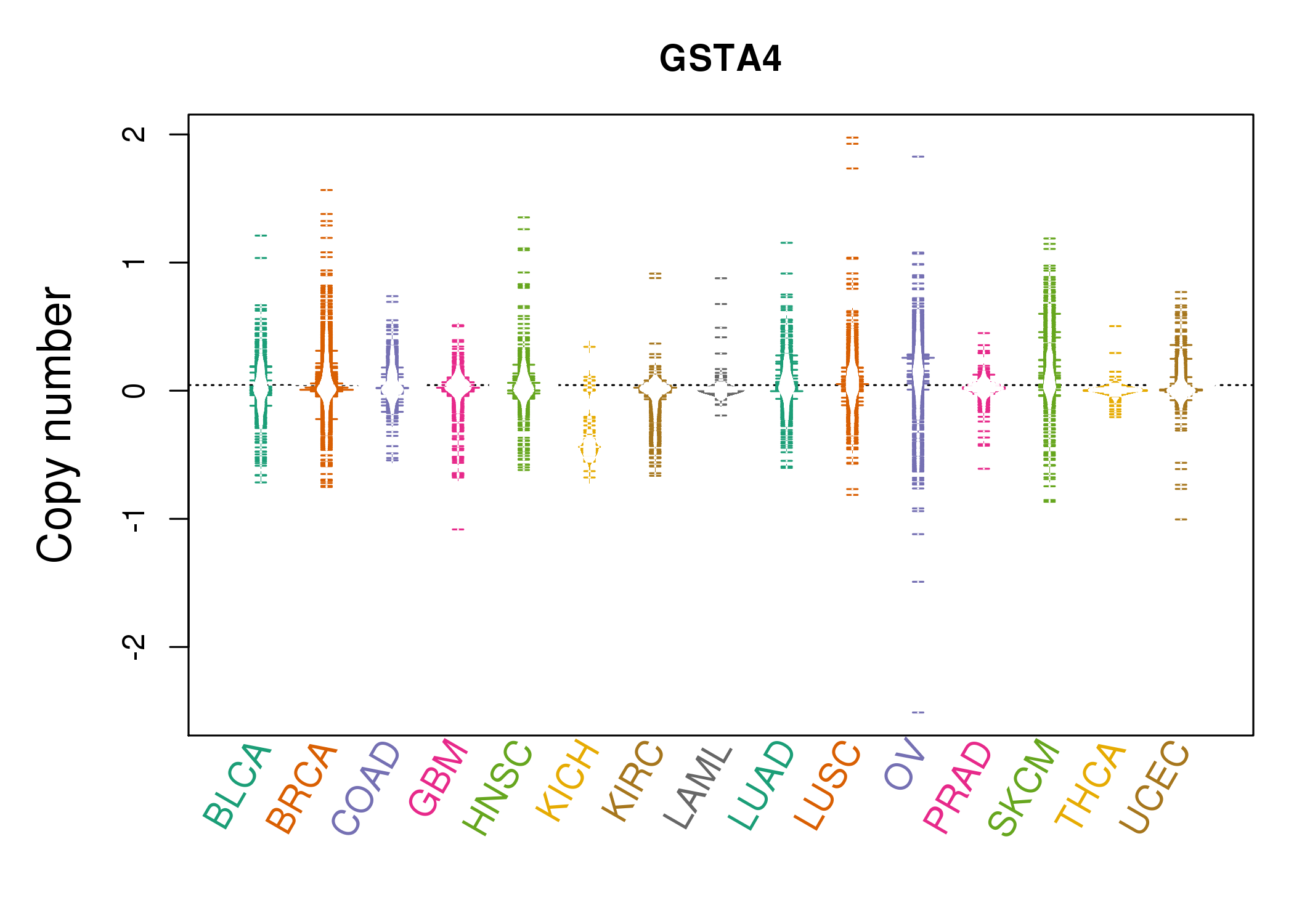 |
| cf) Tissue ID[Tissue type]: BLCA[Bladder Urothelial Carcinoma], BRCA[Breast invasive carcinoma], CESC[Cervical squamous cell carcinoma and endocervical adenocarcinoma], COAD[Colon adenocarcinoma], GBM[Glioblastoma multiforme], Glioma Low Grade, HNSC[Head and Neck squamous cell carcinoma], KICH[Kidney Chromophobe], KIRC[Kidney renal clear cell carcinoma], KIRP[Kidney renal papillary cell carcinoma], LAML[Acute Myeloid Leukemia], LUAD[Lung adenocarcinoma], LUSC[Lung squamous cell carcinoma], OV[Ovarian serous cystadenocarcinoma ], PAAD[Pancreatic adenocarcinoma], PRAD[Prostate adenocarcinoma], SKCM[Skin Cutaneous Melanoma], STAD[Stomach adenocarcinoma], THCA[Thyroid carcinoma], UCEC[Uterine Corpus Endometrial Carcinoma] |
| Top |
| Gene Expression for GSTA4 |
| * CCLE gene expression data were extracted from CCLE_Expression_Entrez_2012-10-18.res: Gene-centric RMA-normalized mRNA expression data. |
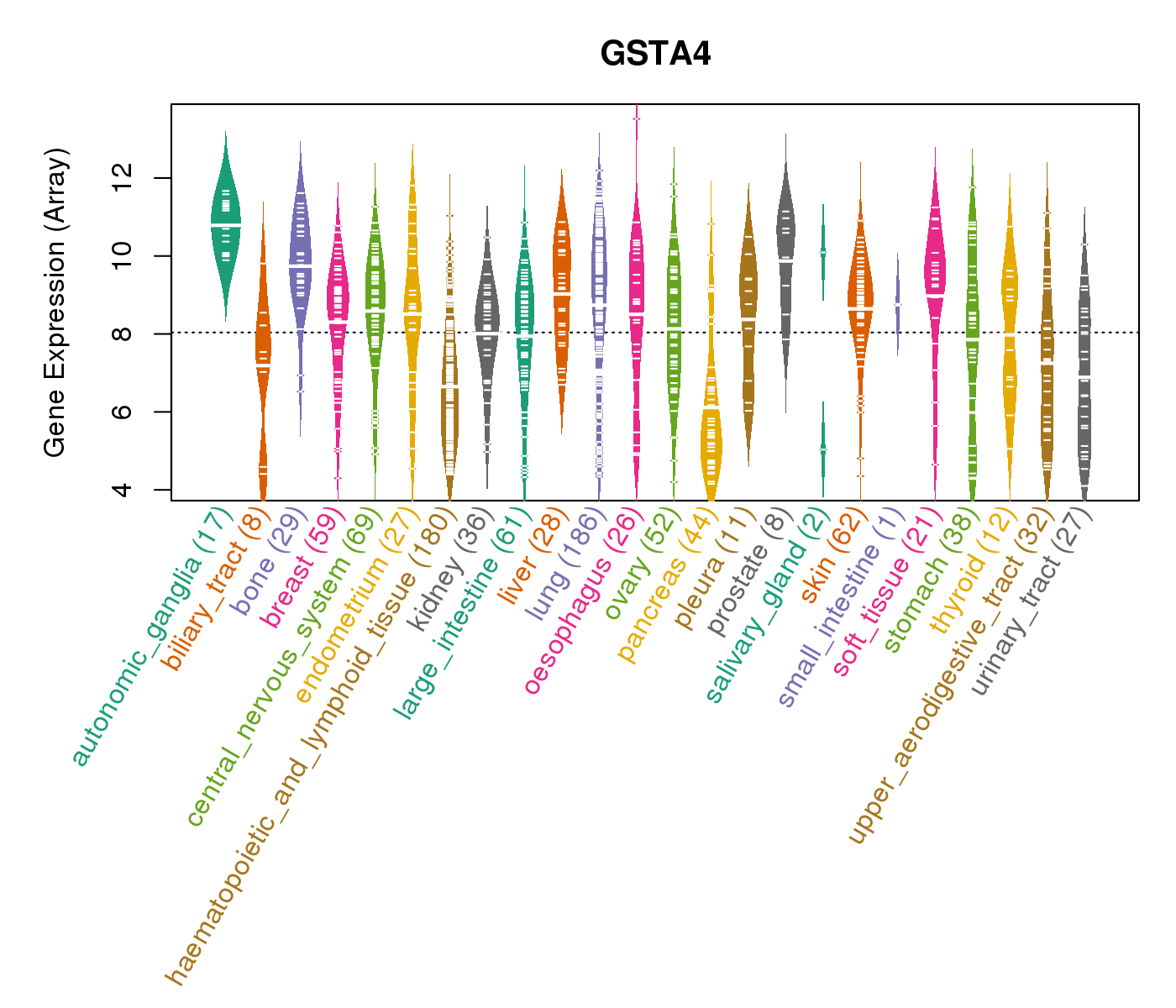 |
| * Normalized gene expression data of RNASeqV2 was extracted from TCGA using R package TCGA-Assembler. The URLs of all public data files on TCGA DCC data server were gathered at Jan-05-2015. Only eight cancer types have enough normal control samples for differential expression analysis. (t test, adjusted p<0.05 (using Benjamini-Hochberg FDR)) |
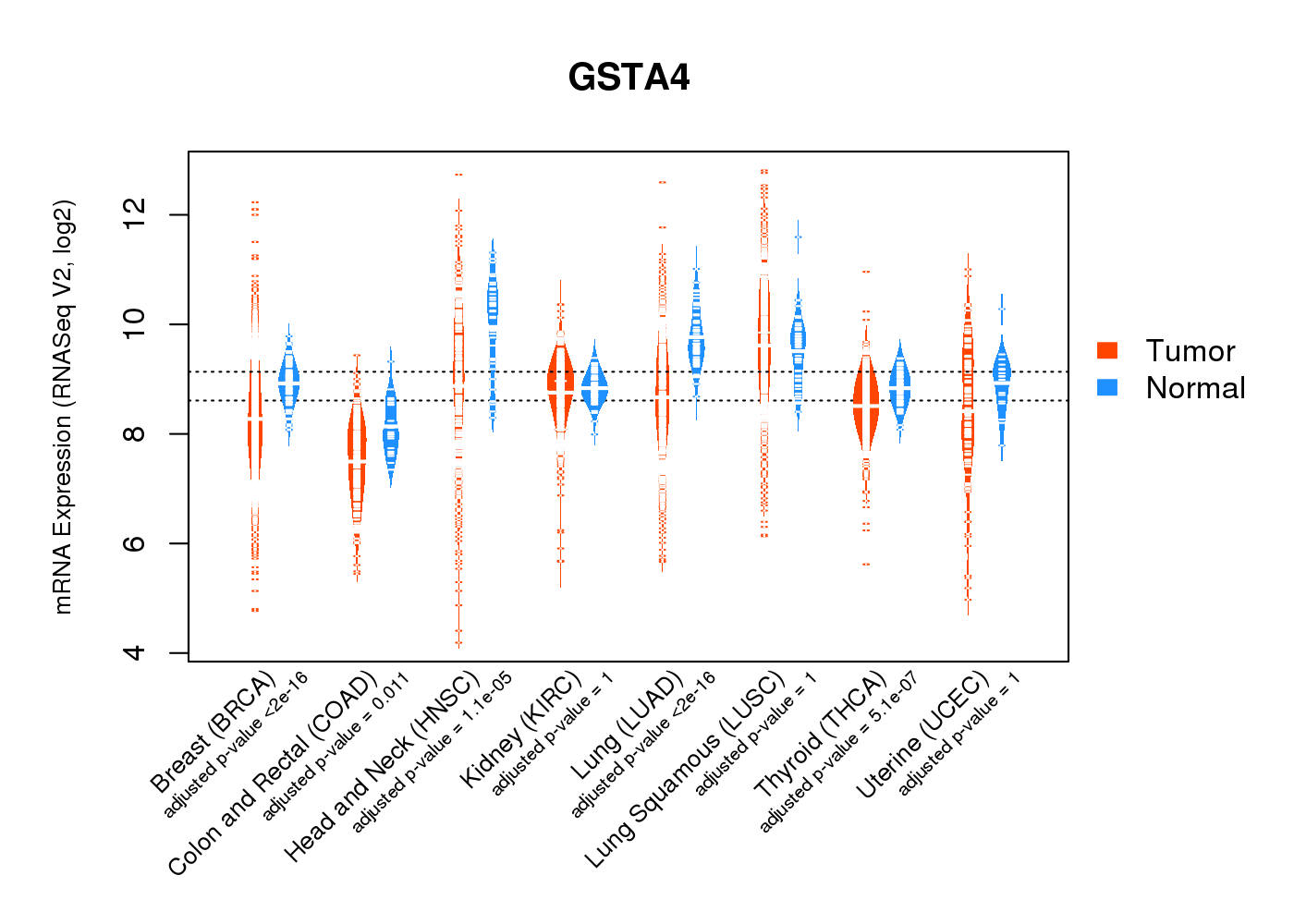 |
| Top |
| * This plots show the correlation between CNV and gene expression. |
: Open all plots for all cancer types
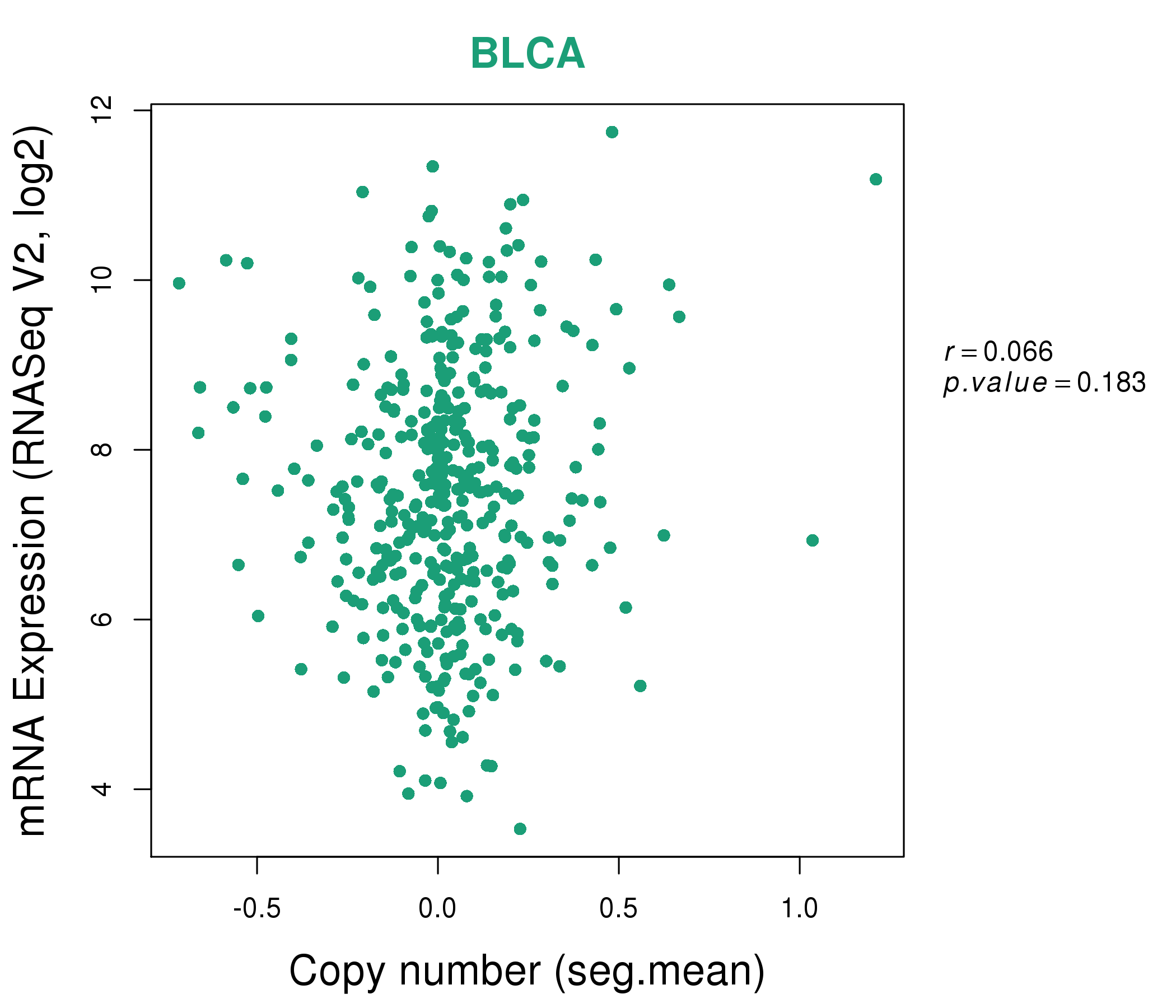 |
|
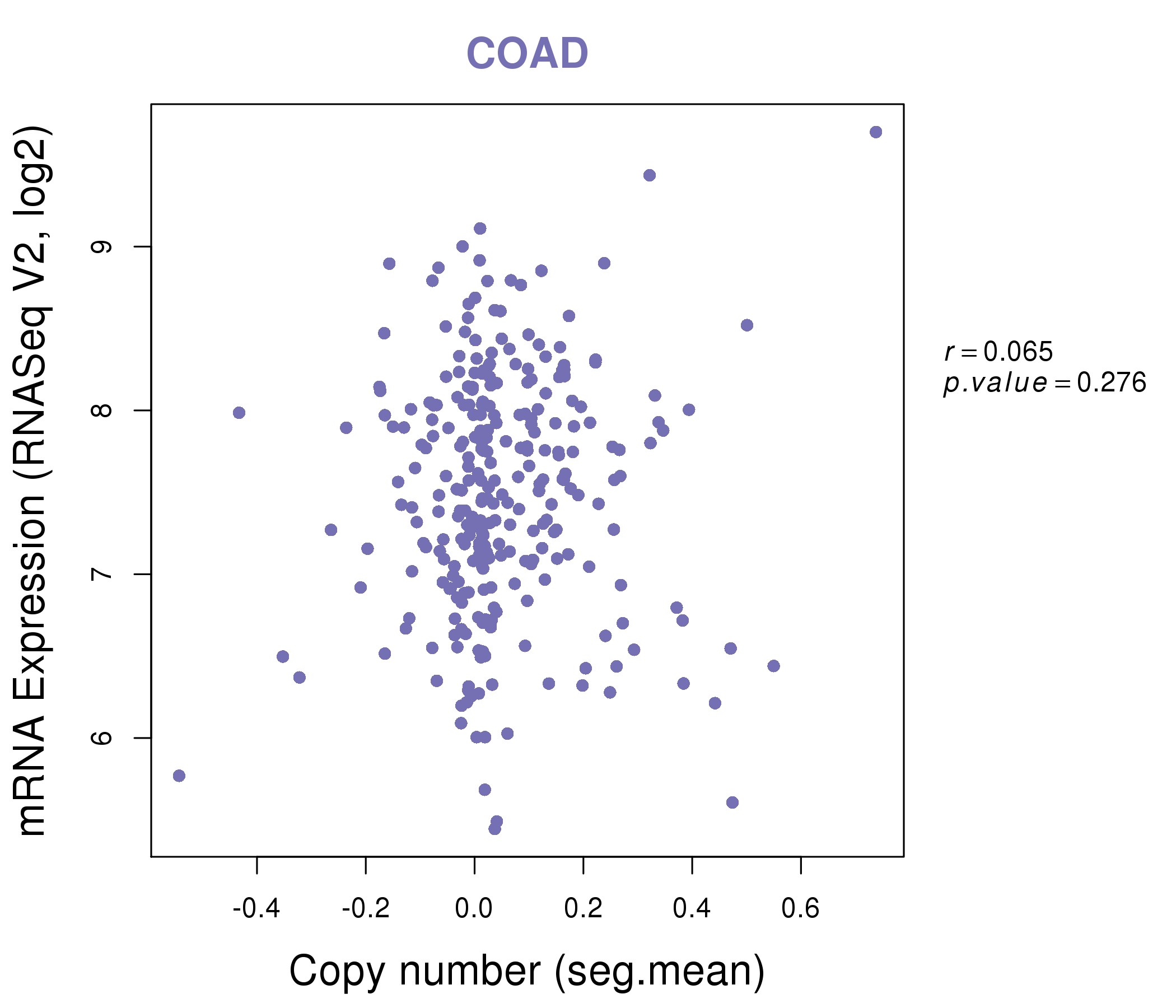 |
|
| Top |
| Gene-Gene Network Information |
| * Co-Expression network figures were drawn using R package igraph. Only the top 20 genes with the highest correlations were shown. Red circle: input gene, orange circle: cell metabolism gene, sky circle: other gene |
: Open all plots for all cancer types
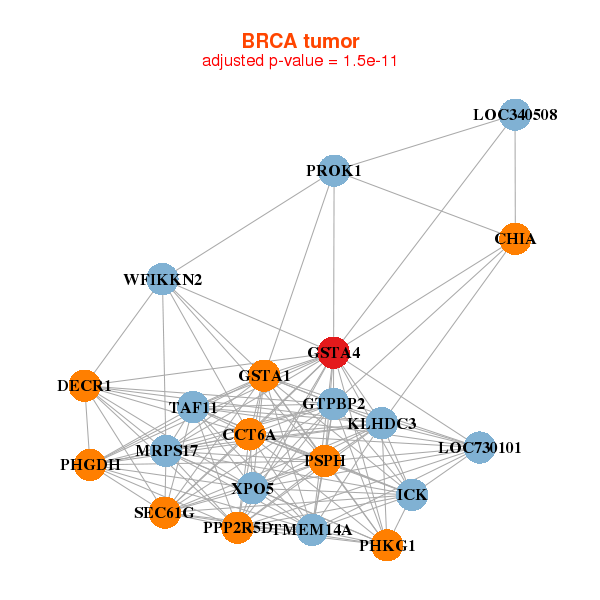 |
| ||||
| CCT6A,CHIA,DECR1,GSTA1,GSTA4,GTPBP2,ICK, KLHDC3,LOC340508,LOC730101,MRPS17,PHGDH,PHKG1,PPP2R5D, PROK1,PSPH,SEC61G,TAF11,TMEM14A,WFIKKN2,XPO5 | C11orf1,C18orf21,CAMKMT,CAMLG,DPH5,EIF2S3,EIF3E, EIF3M,GSTA4,METAP2,NAP1L1,LRRC75A-AS1,PCBP2,PFDN4, PMPCB,POLR1D,RPS13,RPS29,SPATA7,TATDN1,TIMM9 | ||||
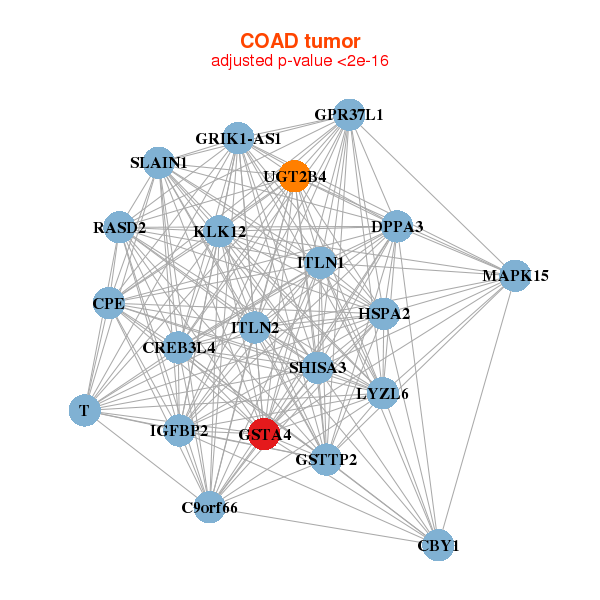 |
| ||||
| C9orf66,CBY1,CPE,CREB3L4,DPPA3,GPR37L1,GSTA4, GSTTP2,HSPA2,IGFBP2,ITLN1,ITLN2,KLK12,LYZL6, MAPK15,GRIK1-AS1,RASD2,SHISA3,SLAIN1,T,UGT2B4 | ASPH,BCAP29,BRMS1L,C10orf35,TMEM263,CFAP36,CDH19, DYNC1LI1,LINC01184,GSTA4,IL33,KIAA0895,LOH12CR2,MNAT1, NFYB,NME4,NME5,REXO2,SRR,TCEAL1,TCEAL8 |
| * Co-Expression network figures were drawn using R package igraph. Only the top 20 genes with the highest correlations were shown. Red circle: input gene, orange circle: cell metabolism gene, sky circle: other gene |
: Open all plots for all cancer types
| Top |
: Open all interacting genes' information including KEGG pathway for all interacting genes from DAVID
| Top |
| Pharmacological Information for GSTA4 |
| DB Category | DB Name | DB's ID and Url link |
| * Gene Centered Interaction Network. |
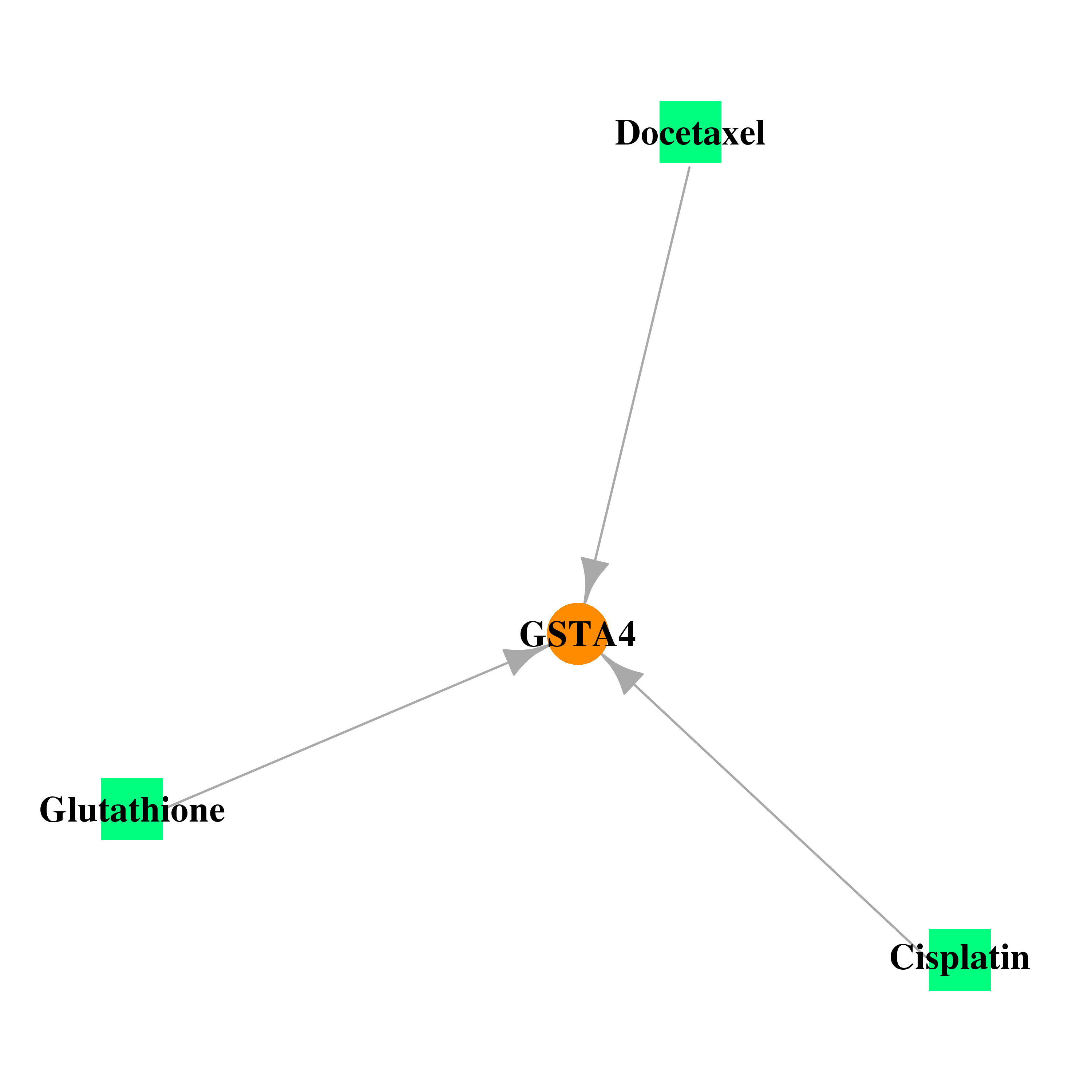 |
| * Drug Centered Interaction Network. |
| DrugBank ID | Target Name | Drug Groups | Generic Name | Drug Centered Network | Drug Structure |
| DB00143 | glutathione S-transferase alpha 4 | approved; nutraceutical | Glutathione |  |  |
| DB00515 | glutathione S-transferase alpha 4 | approved | Cisplatin |  | 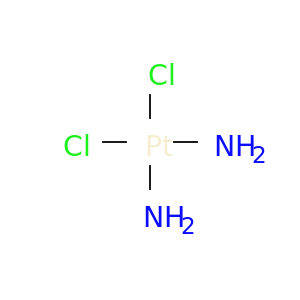 |
| DB01248 | glutathione S-transferase alpha 4 | approved; investigational | Docetaxel | 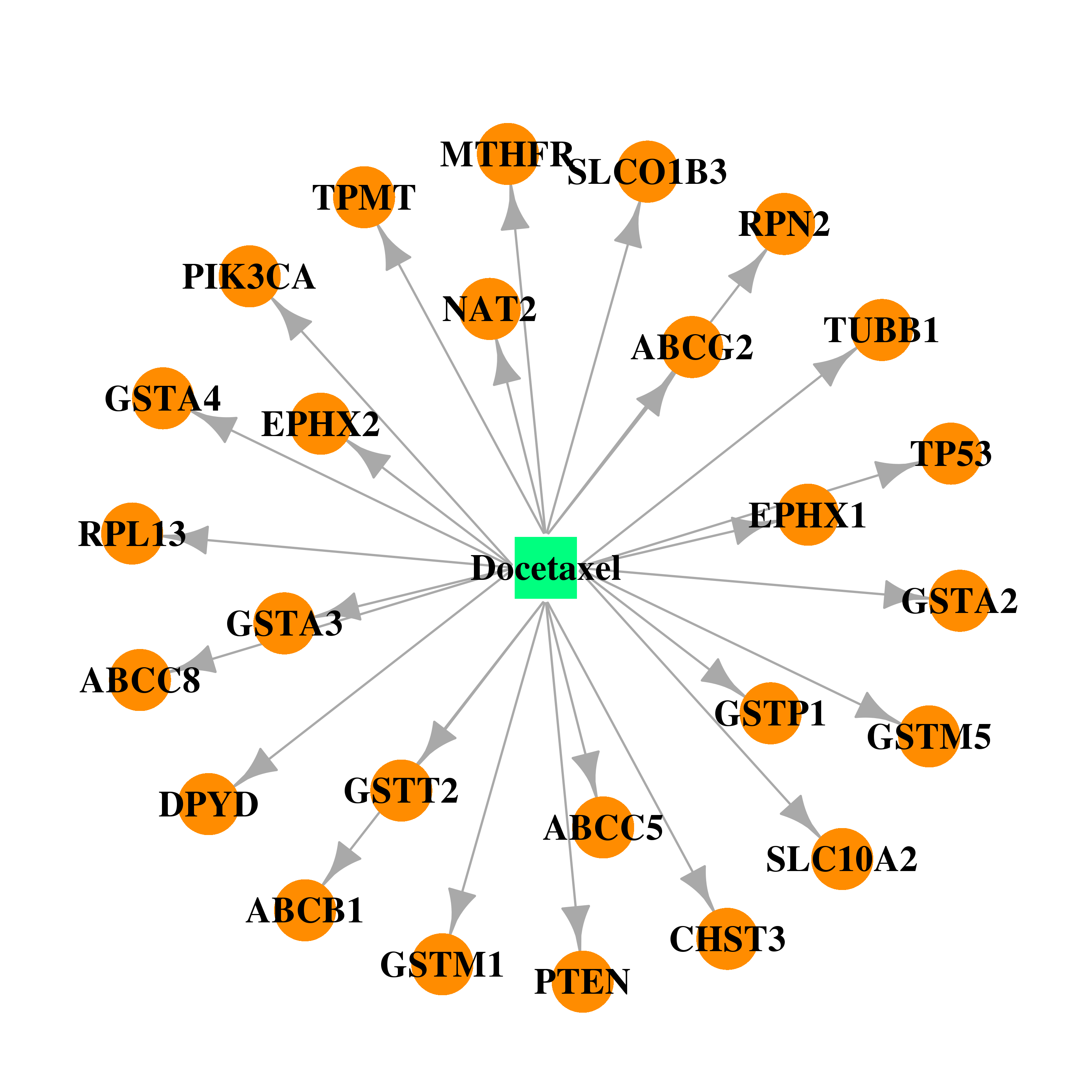 | 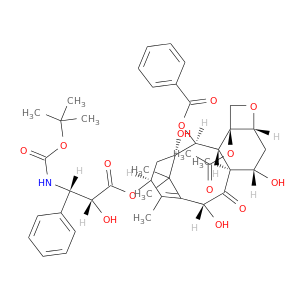 |
| Top |
| Cross referenced IDs for GSTA4 |
| * We obtained these cross-references from Uniprot database. It covers 150 different DBs, 18 categories. http://www.uniprot.org/help/cross_references_section |
: Open all cross reference information
|
Copyright © 2016-Present - The Univsersity of Texas Health Science Center at Houston @ |






